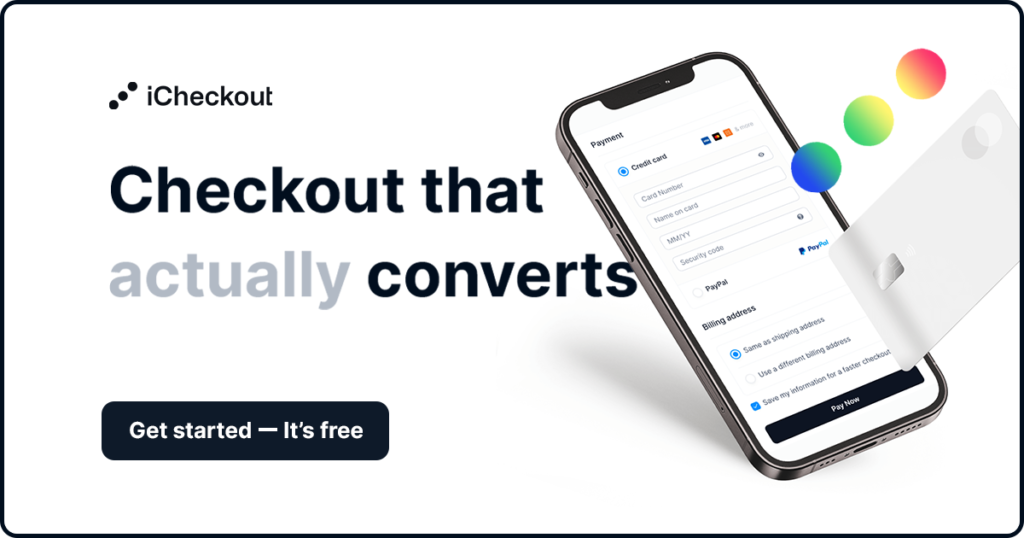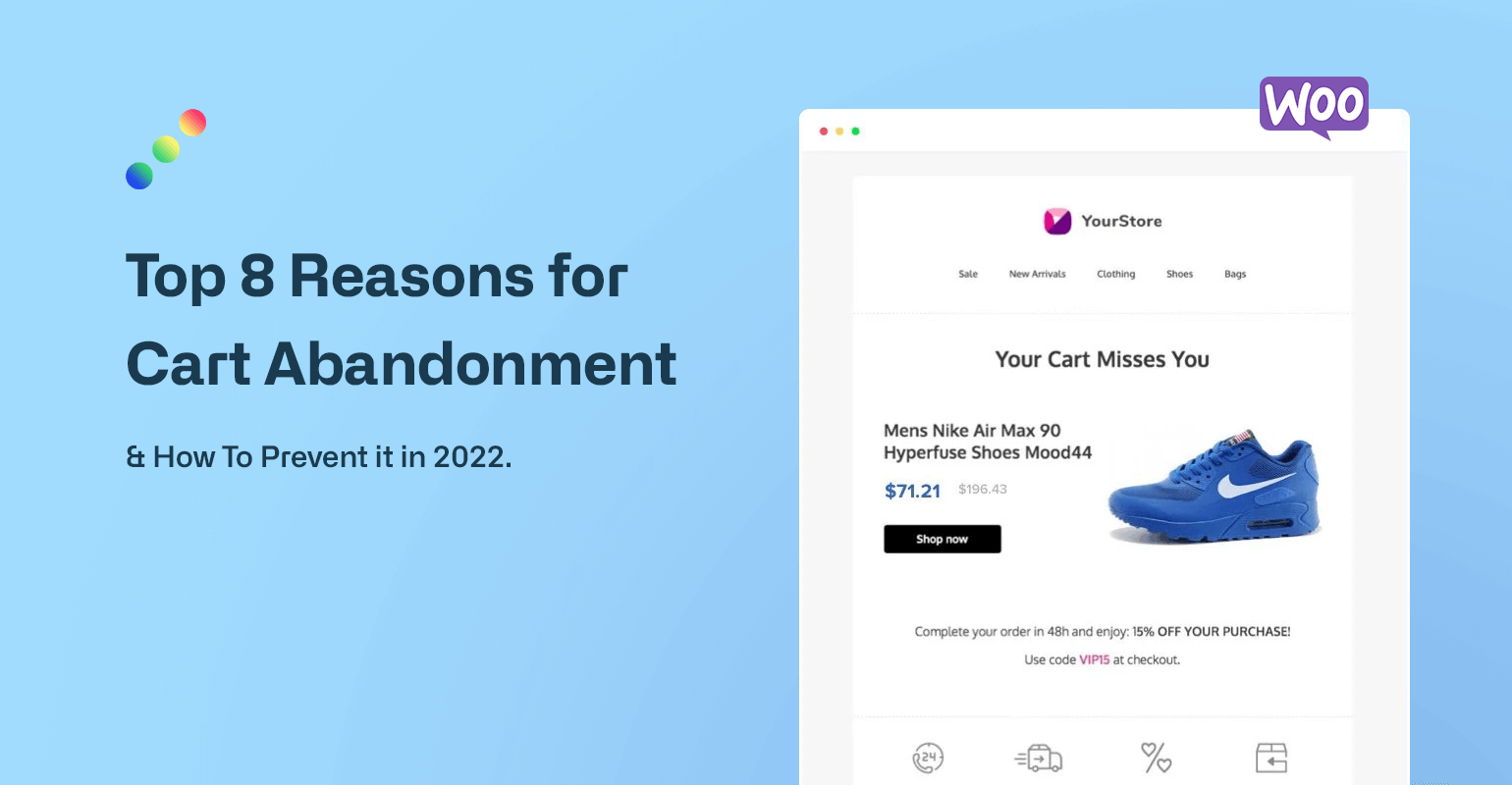Statistics say the shopping cart abandonment rate is about 70% across the web, meaning that every 7th out of 10 potential customers leaves without purchasing.
Just imagine how it is when your customer comes to the end of the checkout page and then, distracted by some reason, decides to leave it.
Looking stressful, right?!
In the online shopping world, cart abandonment is a common problem that most businesses battle all the time.
Businesses are generally losing so much income in this process – approximately about $4 trillion in lost sales yearly.
How about reversing those terrible stats?
While some businesses have found ways to overcome high cart abandonment rates and improve their conversions, many still struggle to find a solution.
We’re here to help you change that.
In this article, we’ll cover the concept of cart abandonment, point out the top reasons for cart abandonment, and provide solutions for each of those reasons.
So if you’re ready, let’s begin!
What Is Shopping Cart Abandonment?
Shopping cart abandonment is when potential customers start a checkout process and add products to the cart but leave the process before completing the purchase.
Any product that enters the shopping cart but doesn’t get purchased is considered to be “abandoned” by the customer.

Shopping cart abandonment is an essential problem in the online shopping process that retailers pay careful attention to.
No company can have a 0% cart abandonment rate because some users will always have a reason to abandon a cart.
According to a study, about 59% of all internet users actually have no actual intention of making a purchase.
They’re just watching products and services and searching for details on the internet.
Many practices show that there are ways to lower shopping cart abandonment rates and keep potential customers interested in what you have to offer, and increase your conversion rates.
How to calculate cart abandonment rate?
The shopping cart abandonment rate identifies the percentage of visitors adding an item to the cart but doesn’t complete the purchase.
The abandonment rate calculates by dividing the total number of completed transactions by the total number of initiated transactions.

The cart abandonment rate is an important Ecommerce metric to keep track of because high-rate abandonments may signal a poor user experience or broken sales funnel.
Reducing shopping cart abandonment directly increases sales and revenue, so optimizing the checkout flow should be a core focus area for your online business.
Top 8 Reasons for Cart Abandonment and Its Prevention
Before finding a solution to cart abandonment, it’s essential to understand its reasons.
Based on Baymard’s Institute research, there are many reasons why carts are getting abandoned, causing a massive problem for all kinds of businesses.

1. High Additional Costs (Shipping, Taxes, and Other Fees)
Customers usually abandon shopping carts after seeing how much their order costs, including additional expenses. Those extra costs can be in the form of taxes, fees, and shipping.
The truth is that many customers don’t want to pay these charges, especially if they come unexpectedly, so this situation can be challenging for sellers.
Did you know that about 23% of potential customers will abandon the process if they do not see the total cost up-front?
Imagine searching for a product under $15, and after adding it to the cart, you notice that the cost increases drastically on the final checkout page.
Solution:
Make sure to present all the costs on the product page and through the whole checkout process.
What’s also a great way to overcome this issue is by offering a free shipping option.
Pro tip: You can include a mini-cart option, making it easier for customers to review the products in the cart, modify the quantity, and finish the buying process faster.
For example, besides all these features within the mini-cart option iCheckout provides you to offer upsells within the mini cart and to motivate your customers with a free shipping meter.
Not only will it help them purchase faster, but also to increase their cart value.
Sounds cool, right?
Let’s get to the next reason.
2. Forcing Account Creation
About 24% of potential customers abandon carts every day if they’re required to create an account before completing the process.
Some merchants make it necessary for customers to register before making any purchase.
On the other hand, some customers are not comfortable giving their personal information, and many find it worthless to fill out lengthy forms for a single purchase.

There are reasons why businesses encourage or require visitors to create an account.
According to studies, logged-in users usually spend 10% more time on the website than guest visitors.
But for some customers, spending more time and effort than expected is a significant source of friction.
Customers want to do things quickly and finish purchasing instantly. Make sure to provide it to them.
Solution
We suggest you give users options to choose whether they want to sign up or use the guest checkout feature.
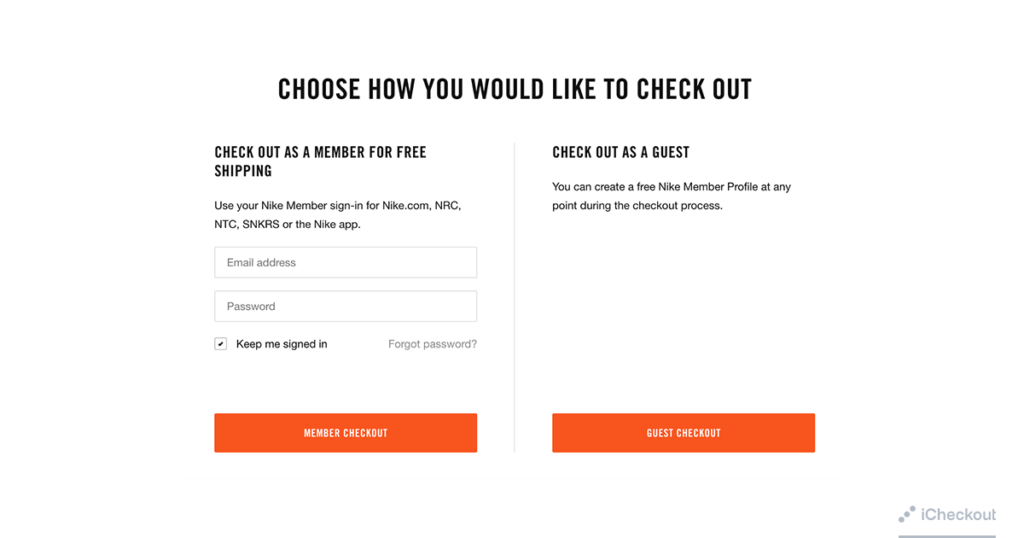
Tip: A good way to make the customers create an account is to offer them discounts for purchases made over registered accounts.
3. Security Concerns
Many customers are afraid of filling out transactional forms. They don’t like providing personal details such as their addresses, phone numbers, and credit card details to people they do not trust.
The visitors who come to your store for the first time or who do not have an existing relationship with your store may take a while to trust you and give you their credit card information.
Did you know that about 61% of potential customers avoid buying on a store that does not display trust logos?
Customers know the risk of data theft is always there. You have to convince customers to choose your business by showing how you protect their data and identity.
They’re more likely to buy from a store that ensures their information and money are secure.
Solution:
What’s great is to highlight the security companies you’re working with and to mention how you secure your visitors’ data.
For example, this includes using SSL certificates and a reliable antivirus program.
Make sure to set logos clearly on your store and checkout process close to payment options.
You can also offer a money-back guarantee because it’s an easy way to win new customers.
4. Slow Delivery and Limited Shipping Options
What customers expect is their items to be delivered in a reasonable period of time. If they have to wait too long, the value of shopping online over going into a store diminishes.
Customers looking to receive their product by a specific date might choose to look elsewhere instead of waiting for your store to ship.
The great thing about Daniel Wellington is that their free shipping is up to 3 days worldwide, providing a fantastic customer experience.
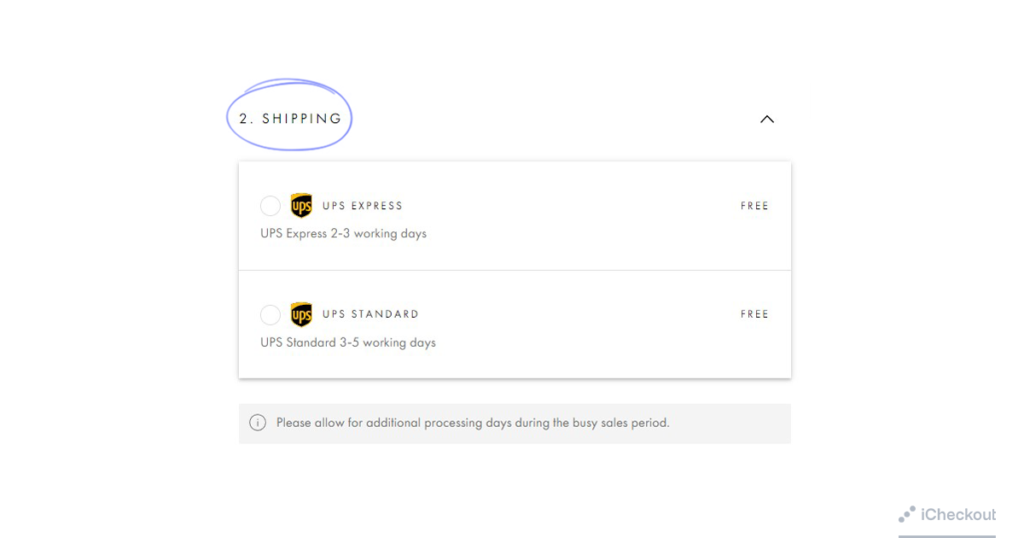
On the other hand, there is more and more businesses that provide same day delivery which plays a big factor in people deciding to buy from those brands.
When a customer starts looking for a particular product, they probably need it for something specific – there is a good chance that your site is not the first one they have visited.
Please don’t make your customers guess how long it will take to receive their goods, and save yourself the unnecessary customer service headache.
Solution:
Providing an estimated delivery date will help customers build up the anticipation of receiving the product and encourage them to finish their order.
Make sure to enable a fast-shipping solution. In case you need to charge customers more for express shipping, then you should do so.
Usually, customers are more willing to spend their money on fast delivery, and you will benefit significantly from providing this option.
5. Inadequate Return Policy
The inadequate returning policy might harm your brand and cause customers not to return anymore.
Since it’s common for online marketplaces to promote false products, a money-back guarantee can help convince consumers to complete the checkout process.
Returns can be an unwanted cost for retailers, so it’s important to reduce return rates as much as possible.
Good product information, great images, and extras like product videos can help ensure that customers know what they’re getting.

However, retailers will never avoid all returns, and an easy returns process can ensure that people are happy to buy again.
Solution:
Clearly display your refund policy and make sure that users are covered if they do not receive what they expect.
An easy and clear returns process can help ensure that customers are happy to make a purchase, as they know they’ll be able to return them if they need to.
6. Lack of Payment Methods
Payment processing can be complicated for many businesses, but that’s not a concern for your customers.
What customers want is fast and easy payment processing, and about 56% of customers want to see multiple payment options.
Today’s most popular choices include online wallets such as PayPal, Google Pay, Apple Pay, credit and debit cards, and even cash on delivery.
However, the right payment option depends on where you operate.
Customers want to complete their purchases using the payment methods that are most convenient for them. Here are the most preferred ways of payment:

For example, PayPal isn’t available in some countries.
Some customers may be willing to accept the default option, but your inability to support others’ preferred method may cause them to leave – whether it’s PayPal, Apple Pay, or a buy now, pay later option.
Also, there is a small number of store owners that allow payment on delivery.
Solution:
Offering multiple payment options minimizes potential reasons customers have to abandon their cart and buy elsewhere.
The more payment options you provide to your customers, the better it is for you as a business owner (and you can set higher fees), and that’s what it’s all about.
It’s also great to include pay on delivery, causing 23% of shoppers to prefer this payment method.
7. No Coupon Code Available
Some customers chase popular deals. If they don’t find a coupon or promotional code, they tend to look for one elsewhere.
According to Statista, 8% of customers by not being able to find a coupon code have a big reason for cart abandonment – opting instead of waiting until one shows up and trying and find a better deal elsewhere.
Some checkout processes, unfortunately, encourage the feeling of missing out on a special deal.
Solution:
The best practice here is to auto-apply coupons when able, which only a few stores and checkout tools are doing.
8. Major Website Performance Issues
Website errors, crashes, and load times are huge issues in completing a purchase and contribute to a sense of insecurity on the site.
The statistics show that Ecommerce cart abandonment isn’t just about what happens at the checkout.
The overall user experience on your store significantly impacts whether potential customers buy or abandon their carts.
Statista says that poor site navigation is an issue for 16% of online customers. It’s a huge turnoff when you land on a site and can’t undisturbedly find the items you intend to buy.
Baymard Institute adds that 13% of users will abandon their carts if the site crashes or has some errors.
Most visitors don’t bother to look for the product they need. If your store doesn’t work for them, they’ll just go elsewhere.
Solution:
Focusing on the customers’ experience is paramount.
Ensure that you are regularly going through your site, ensuring that your store and checkout page are up to date and that there are no issues.
You should perform these tests across various screen sizes, especially on mobile, as their importance grows daily.
You can check mobile optimization and site speed through several free services, such as Google Pagespeed Insights.
Also, Check Mobile optimization to see if your site is optimized for mobile devices.
Top 5 Strategies To Minimize Cart Abandonment Rate and Maximize Conversions
While the tips above were the proactive way to decrease cart abandonments, these extra strategies will also help you improve your checkout process and conversion rate.
1. Make Stronger CTA’s
Many sites fail to include any CTA’s on their checkout pages. The “logic” behind this is the assumption that if a potential customer has added the product to their cart, then you no longer need to call them to buy it.
Consider testing CTA’s, including clearer, more active words to see whether your CTAs are helping visitors understand what they’re doing and what’s expected of them.
For example, something like “Complete Purchase” or “Purchase now.”

Also, make sure to be consistent and use the same CTA’s depending on where the potential customers are in the process, especially if you’re using some kind of a progress indicator.
Don’t jump and make assumptions about users’ understanding of where they are in the process.
2. Exit-Intent Popups
Exit-intent popups are easily defined as a website’s last chance to stop a user from leaving.
Once the system detects a potential customer is about to abandon the cart without completing the purchase process, it will display a popup window designed to motivate the user to complete it.
You must understand why users are leaving your site to show the right popup message.
Let’s say you feel a user is leaving the site due to high costs, you can show a popup that offers free shipping or a special discount code to motivate users to purchase.

Exit-intent popups are effective ways to increase conversion rates and install them on almost all pages, including your checkout and shopping cart pages.
Since they’re popping up when a user has already decided to leave, they’re not as irritating as other kinds of popups.
Plus, you can get your potential customers’ emails, which you can use later to send retargeting emails.
3. Offer Live Chat and Support
An extra benefit of online shopping is that you can get access to the staff who are always ready to help you find items or answer your questions.
You can mirror this same level of care and attention by integrating customer support options into your checkout flow.
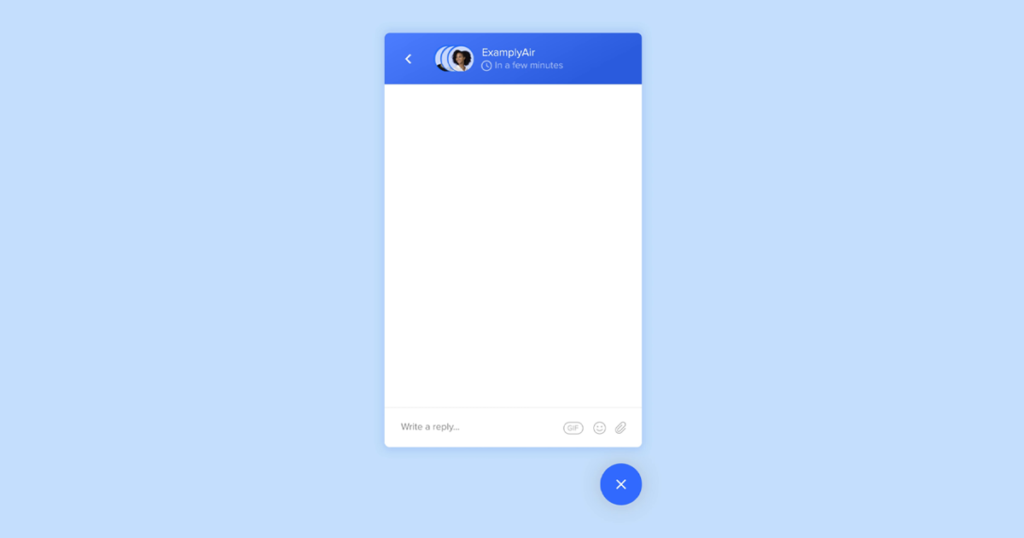
Lastly, a lack of online support is detrimental to shopping cart abandonment rates.
51% of potential customers said they are more likely to purchase if they have customer support, such as live chat, during their purchasing.
Using cart abandonment data, you can identify areas where customers are most likely to drop off and allow users to chat with customer support to reduce abandonment.
4. Cart Recovery Emails and SMS
Following up a warm lead after they abandon a cart increases your chances to convert drastically.
You can use cart recovery emails and SMS to follow up with potential customers after their cart abandonment.
Remind shoppers they haven’t completed their purchase and offer them to resume their shopping where they left off.
To streamline the process, consider populating a link that takes them to the exact stage they were at before they left.
Offering a small discount is also an excellent way to entice shoppers to revisit their purchases and convert.
5. Use Remarketing to Target Abandoners
Facebook remarketing is the perfect way to target shopping cart abandoners.
As Facebook ads are inherently visual, they’re ideal for capturing your products’ aspirational qualities that attracted your visitors in the first place.
With that said, remarketing with Google AdWords and Bing Ads is also a great idea. However you do it, you absolutely must use the power of remarketing to bring back the customers who abandoned their shopping carts.
Remarketing is absolutely essential for Ecommerce retailers, more than for any other type of online business or advertiser.
Suppose you’re not doing remarketing to potential buyers who are close to converting. In that case, you’re effectively restricting yourself to just one chance at getting visitors to convert in a single session, which in many cases isn’t possible.

Although the previous tips can help you reduce shopping cart abandonment, remarketing enables you to get back the potential customers that you may lose along the way.
Summary
Understanding the problem and reasons for cart abandonment is a precondition to successfully solving a problem with conversions.
I hope this advice and strategies will help you identify all your checkout shortcomings in order to overcome cart abandonment and increase your conversion rates.
To reduce your efforts in solving these problems and make it easier for you, we created iCheckout.
With a flexible WooCommerce iCheckout plugin, you can customize your checkout pages to fit your business and increase your conversions.
With thousands of Ecommerce elites, we’ve built the ultimate checkout process that redefines the purchasing experience while keeping it secure, easy, and seamless.
Customers shouldn’t spend more than 25 seconds on the checkout page, and we made it possible for them while increasing your revenue by almost 30%.
You can choose which payment options you want to provide with a single click. Our job is to consistently keep you and your business in front of your customers.
Here’s what iCheckout got to our early users:
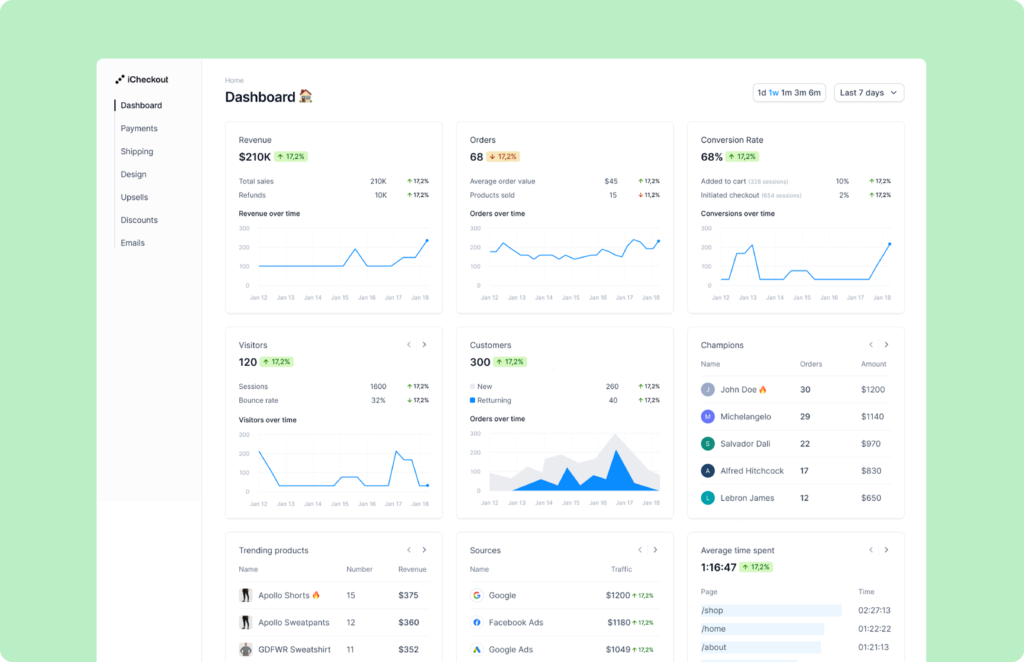
Leverage the power of social proof, textual motivators, and mini-cart options at every step of the checkout process and increase your revenue by almost 30% through automatic discounts and the smartest upsells you have ever seen.
Minimize checkout abandonment rate, and increase your sales and revenue now!
Get started with iCheckout!
Join our waitlist, and be among the first beta users when iCheckout gets live!
